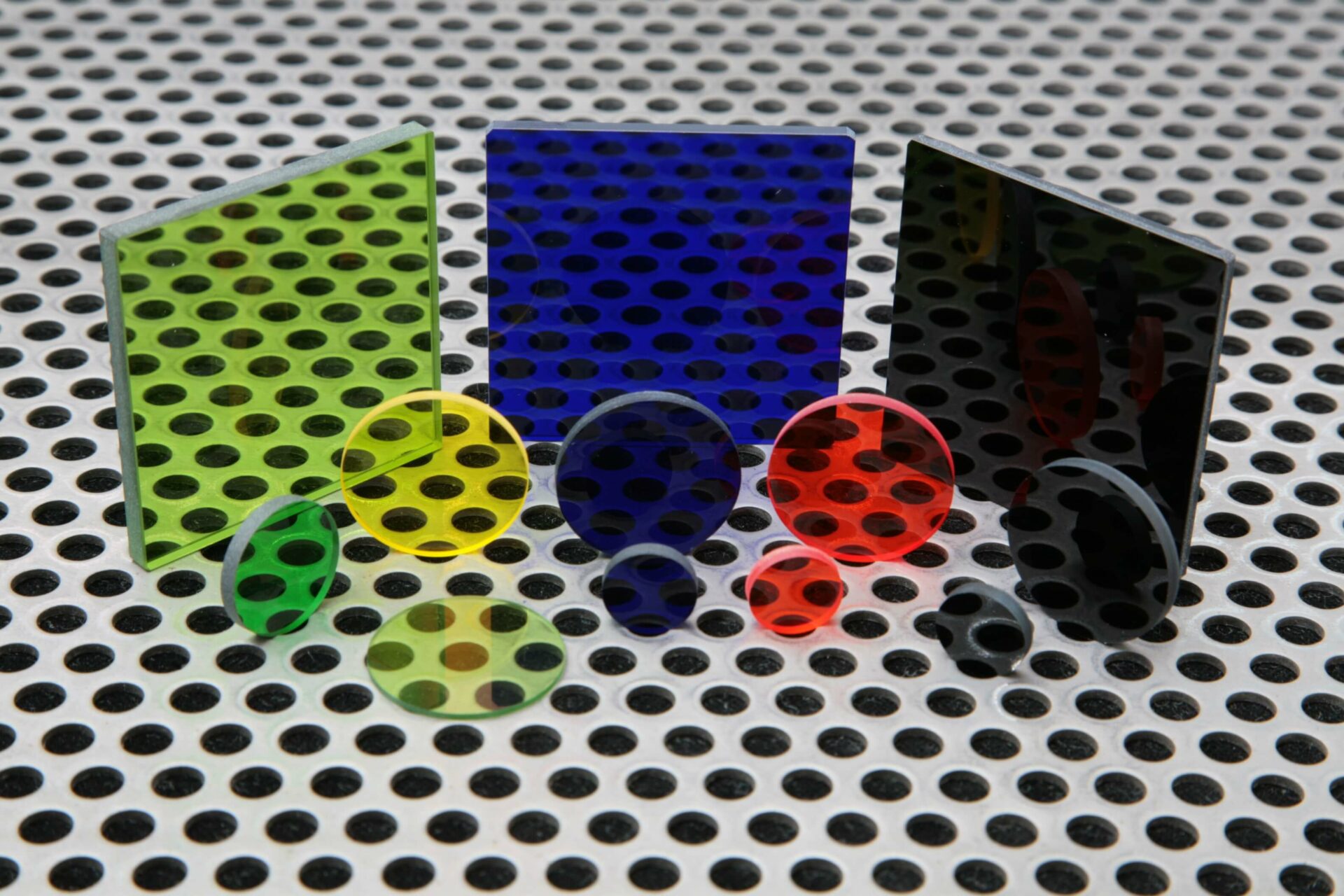An optical filter is used for the selective and non-selective control of a specific spectrum or wavelength of light. They transmit or attenuate light by allowing certain wavelengths to pass through the filter freely, while blocking others as required by the application.
What are Optical Filters used for?
Optical filters are used by many manufacturers of scientific instruments, engineering and equipment around the world. There is also a large demand for optical filters for the research and development sector.
Sectors using optical filters include medical and life sciences, industrial manufacturing, electronics, commercial, forensic science and consumer goods, entertainment and defence.
The latest use is in sensors, testing and lab instrumentation used in the fight against Covid-19. These can be UV filters and bandpass filters made to precise wavelengths.
Practical applications include sensors, calibration, imaging, microscopy, spectroscopy, chemical analysis, machine inspection and photographic – from professional cameras through to ANPR cameras.
What are the key properties of Optical Filters?
The two main classes of optical filter are absorptive filters and interference or dichroic filters.
The difference between absorptive optical filters and dichroic optical filters lies in the degree to which each type of filter reflects or absorbs light.
Absorptive filters
Absorptive optical filters, as the name suggests, are designed to block certain light wavelengths by absorbing the unwanted light within the filter. The substrates of absorptive filters are coated with various light absorbing materials according to the specific wavelengths which need to be blocked or to pass through.
Absorptive filter summary:
- Absorb rather than reflect light
- Produced using absorbing materials
- Simple function
- Angle insensitive
- Ideal in systems with light noise
Dichroic filters
Dichroic filters, unlike absorptive filters, are designed to reflect unwanted wavelengths and to transmit only the desired wavelengths. This is achieved by assembling one or more layers of refractive coating materials on the substrate.
The layers cause interference by reflecting light on different paths, reinforcing other light wavelengths and cancelling others, thus separating out the desired from the undesired wavelengths. The simplest dichroic filters consist of just a single pair of reflecting layers and a spacer layer.
Dichroic filter summary:
- Reflect rather than absorb light
- Commonly used for longpass and shortpass applications
- Also called interference filters or thin-film interference filters
- Highly accurate
- Ideal for passing light of specific colour range, reflecting others
- Can be used with high intensity light sources up to 287°C.
Further types of Optical Filter
Optical filters can also be classified according to a range of other categories.
- Shortpass filters: block longer wavelengths above a certain cut-off level but transmit shorter wavelengths below the set level uninterrupted. Perform the opposite function to longpass filters.
- Longpass filters: block shorter wavelengths below a certain cut-off level, but transmit longer wavelengths such as infrared, ultraviolet and visible light.
- Bandpass Filters: transmit only a set wavelength range in narrow or broad pass bands, but block or restrict other wavelengths. Bandpass filters are angle sensitive, and transmit less light than shortpass and longpass filters but are used to achieve a wider or narrower range of light transmission.
- Monochromatic filters: transmit only a single colour or narrow wavelength.
- Notch filters: transmit all wavelengths except for a single selected bandwidth or narrow band.
- Infrared filters: transmit visible light but block mid-infrared light.
- Ultraviolet filters: transmit visible light but block ultraviolet light.
- Neutral density filters: transmit all wavelengths but reduce light intensity by filtering parts of each wavelength. May be absorptive or reflective filters.
- Polarised filters: transmit, brighten, darken or block light (such as that causing reflection) depending on high or low levels of polarity.
Optical Filter Ordering Specifications
When ordering optical filters, a range of specifications should be considered.
- Bandwidth: part of the spectrum transmitted through a filter.
- Full Width Half Maximum (FWHM): area of a filter allowing more than 50 % transmission.
- Blocking range: wavelength range blocked by an optical filter, usually less than 50%.
- Central wavelength: wavelength at the central point, usually where maximum transmission is possible.
- Cut-on/cut-off wavelength: wavelength at which transmission reaches 50% in a longpass optical filter or shortpass optical filter respectively.
- Optical density: level of light attenuated by a filter. Note that a higher optical density value indicates a lower transmission level.
- Slope: percentage of cut wavelength with specific start and finish points.
Optical Filters from UQG Optics
UQG Optics supplies a full range of optical filters from ultraviolet (UV) to infrared (IR). The precision properties of optical filters are achieved by embedding in the glass as solid state or applying multilayer optical coatings.
We offer industry-specific filters by optical and glass specialists Schott and Hoya, covering a full range of colour glass filters, along with high quality coatings from leading optical coaters.
Depending on the application, low-cost options can be accommodated with special selection of a particular filter. Optical coating selection depends on primary transmission range required. We offer a wide range of optical coatings for different wavelengths.
Our range of optical filters includes; colour glass filters, cut off and blocking filters, heat control filters and ND (neutral density) filters.
All our optical filters can be supplied from a standard range stock, while custom sizes and specifications can be custom-made to your specific design.
Next Steps
To find out more about Optical Filters from UQG Optics, or any of our other optical components call us on 01223 420329 or email our sales team at info@uqgoptics.com




